Research - (2020) Advances in Dental Surgery
Knowledge, Attitude, and Practice on Use of Personal Protective Equipments among Dental Practitioners of Tamilnadu
Sushma Gopalakrishnan, Kavitha S and Geo Mani*
*Correspondence: Geo Mani, Department of Pedodontics and Preventive Dentistry, Saveetha Dental College, Saveetha Institute of Medical and Technical Sciences, Saveetha University, Chennai, India, Email:
Abstract
Dentistry is predominantly a surgical discipline, it leads to exposure to the pathogenic microorganisms harbored in blood, body fluid, and other potentially infectious material. Thus, using good quality PPE is very important for infection control in dental practice. With the growing potential of India’s dental market, the growth of the market for PPE is also high. It is equally important to raise the awareness among the dental community about the usage of good quality products of required standards to prevent the usage of low cost, uncertified and substandard products that decrease the safety levels of personnel. The main purpose of this study is to evaluate knowledge, attitude, and practice regarding the use of personal protective equipment among dental practitioners. The survey was conducted among 205 dental practitioners. They were given a questionnaire consisting of 18 questions through an online platform. The responses collected were statistically analyzed through SPSS software. Descriptive statistics were done. Percentages and frequencies were calculated and to test difference among variables chi square test was done with a p value <0.05 considered statistically significant. 33.2% of respondents preferred disposable aprons as their protective clothing 41.5% mentioned that they change their gloves always. Another important aspect evaluated was the use of Jewelry, 40% of the respondents removed their watches and jewelry during the dental procedure. It was found that dental practitioners had adequate knowledge regarding the use of personal protective equipment although the percentage of respondents with inadequate knowledge and practice requires attention and adequate measures should be taken to improve their awareness on use of PPE and hygiene practices.
Keywords
Dentistry, Personal protective equipment, Infection control, Questionnaire Survey
Introduction
Dental practitioners are exposed to various health hazards in their day-to-day practices. They are prone to be affected by constant exposure to various dental materials, noise from various types of equipment besides work-related stress directly related to patient management [1]. These could have an effect on the health of the practicing dentists and can lead to early burnout [1-3]. Dentistry is recognized worldwide to be associated with deliberating repercussions from associated occupational hazards and is acknowledged as a high-risk profession [4].
Dentistry is one of the disciplines of health care that deals extensively with body fluids like saliva, blood, and gingival crevicular fluid. The frequent exposure to infectious agents can also pose major risks for the dentists [5,6].
Personal protective equipment-these are types of equipment that are designed in a fashion such that they block the portal of entry of microbes during contact with such vicious fluids. Infections in a dental department can be contracted through one of the following routes: direct contact with blood, saliva, gingival crevicular fluids and indirect contact with contaminated instruments, operator equipment, and environmental surfaces, with airborne droplets, aerosols, and splatters. These are potential sources of infection by microbes such as hepatitis B virus, human immunodeficiency virus, mycobacterium, tuberculosis, herpes simplex virus, staphylococcus, and streptococcus [4].
The canal preparation in primary teeth using hand instruments can result in iatrogenic errors if proper safety measures are not followed [7]. The methods of use of disinfectants can be divided into community-based population, individual and professional use [8,9]. Salivation assumes a significant job in support of oral well-being and furthermore against dental caries as the first line of protection [10]. There are various case reports, case-control studies, and cohort studies in the literature regarding the importance of personal protective equipment [11] Rotary endodontics involved an electrically-powered instrument which performs the root canal treatment and replaces the traditional stainless-steel manual files which were earlier used to treat dental caries specifically among children these involved splashing of blood, thus proper personal protective equipment was required here [12–14]. Kedo file system is an exclusive endodontic file used for preparing root canals of primary teeth. [15,16]. Dental equipment used for frenulum examination, traumatic injuries, oral ranula, and any treatment should be sterilized properly and proper personal protective equipment must be used [17–19]. The hand files come into contact more intimately with the patient's profound tissues, for example, nerve tissue and vascular tissue; consequently, the danger of cross-contamination by pathogens is high, and cleansing systems should fundamentally be related with sanitization strategies, thus usage of personal protective equipment (PPE) is very important [20].
The main personal protective equipment is the face mask, cap, gloves, gown, and goggles/ protective eyewear. Each personal protective equipment is designed in such a way that they protect the operator from contamination by aerosols and splatter to the skin and mucous membranes. Contamination of the operator’s clothes that have the possibility of carrying the contamination outside the clinic environment [21]. The personal protective equipment is selected based on occupational safety and health administration regulations as follows [22]. -Category 1 -tasks involving exposure to blood, bloody fluid, or tissues, for example, dentists [23,24]. -Category 2 —errands that include no introduction to blood, body-liquids, or tissues, for instance, administrative or non-proficient specialists who may assist with tidying up the workplace, handle instruments or impression materials or send dental material to the lab-, [7,20].
However, the use of personal protective equipment is not always in accordance with the regulations and is also based on one’s comfort protective equipment as follows:
Fit, biocompatibility, longevity, cost, comfort, style and fashion [25]. However, low cost, uncertified, and substandard products that decrease the safety levels of personnel and erode the market shares of certified personal protective equipment manufacturers currently dominate the market. The high price sensitivity among end-users discourages market growth in terms of its revenues. Further, no incentives are available for those dental practitioners who adopt high-quality product offerings. Some end users even tend to reuse disposable personal protective equipment, especially protective clothing and gloves [26]. The Indian personal protective equipment market’s foremost challenge is to create more awareness among end-users about the correct personal protective equipment products especially protective gloves to be used in various industries [27,28]. Lack of enforcement of government’s occupational and safety regulations only reduces the potential of the total personal protective equipment market.
Inadvertent use of PPE can expose dental practitioners to communicable diseases such as HIV, Hepatitis, the recent viral infection COVID-19, etc. Proper selection and usage of personal protective equipment are of paramount importance in the field of dentistry for the safety of dentists as well as the auxiliary staff [27,29]. Hence, the aim of this survey was to evaluate the knowledge, attitude, and practices of dental practitioners on hygiene measures and awareness on the use of personal protective equipment.
Materials and Methods
An online survey was conducted among 205 dental practitioners to evaluate their knowledge, attitude, and practice on hygiene and awareness of the use of personal protective equipment. A convenience sample was taken and the questionnaire was distributed on an online platform. This online questionnaire survey consisted of 18 questions that were distributed to the study population through google forms. Among those questions prepared in the questionnaire 5 questions involved knowledge, 5 questions involved awareness, and 5 questions involved practice-based questions. The questionnaire was assessed by experts in the field for validity and reliability. The same was assessed by conducting a pilot survey in a smaller sample size. Some salient points covered in the questionnaire included questions about regular hand washing, sterilization of instruments, disinfection of the dental chair, clinic, and dental office. The questionnaire validity checking was done through standard manner. Descriptive statistics were done, percentages and frequencies were calculated and to test difference among variables chi square test was done with a p value <.05 considered statistically significant.
Data Analytics Data was entered into a spreadsheet using Excel version 16.37 (Microsoft Corp, Redmond, Wash). The data tabulation in Excel was according to S.no, education qualification, Gender, knowledge, attitude, and practice about personal protective equipment. The data which was collected was analyzed using Statistical Package for Social sciences (SPSS) software, version 1.0.0.1347 64 bit (IBM corp., NY, USA). The data were assessed by being subjected to descriptive analysis with the help of frequencies, percentages, means. The data was represented by the means of bar graphs. Chisquare test was used and results were correlated and associated.
Results
The study evaluated knowledge, attitude, and practice regarding the use of personal protective equipment among dental practitioners the total number of participants involved in this survey was 205.among the study sample, the number of male dental practitioners was 48.3% and the number of female dental practitioners was 51.8%. the education qualification the participants was 56.1% BDS and 43.9% MDS among the MDS participants field of specialization was 15.65 % orthodontics,20.6% pediatric dentistry, 16.7% periodontics, 12.8% prosthodontics, 8.9% oral and maxillofacial surgery and 11.7% endodontics. 43.5% had 0 to 3 years of experience in this field, while 41.5% had 3-6 years of experience and 15.1% had 6 plus years of experience among the participants 25.9% was less than 25 years,38% was between 25 and 35 years, 27.88% was between 35 and 45 years and 8.3% was 45 years and above. The responses of participants to various questions evaluating the awareness on PPE & hygiene measures are depicted in the figures included (Figures 1-14).
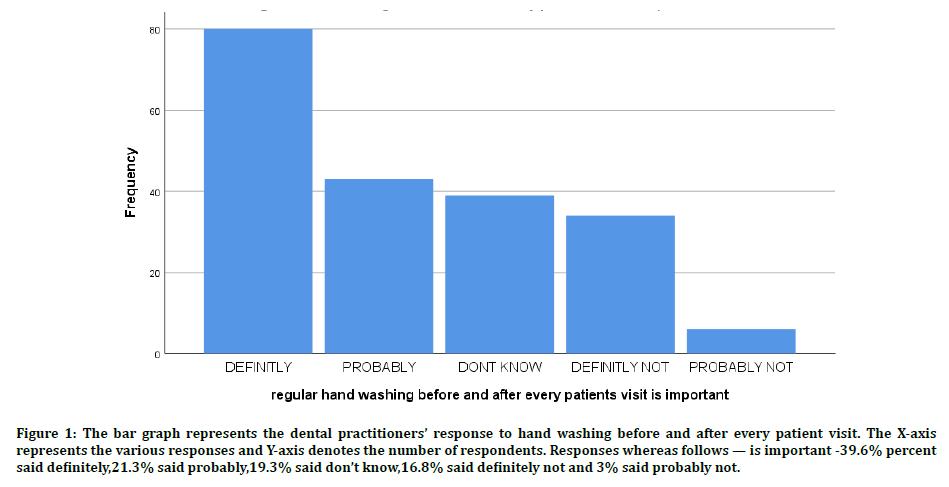
Figure 1: The bar graph represents the dental practitioners’ response to hand washing before and after every patient visit. The X-axis represents the various responses and Y-axis denotes the number of respondents. Responses whereas follows — is important -39.6% percent said definitely,21.3% said probably,19.3% said don’t know,16.8% said definitely not and 3% said probably not.
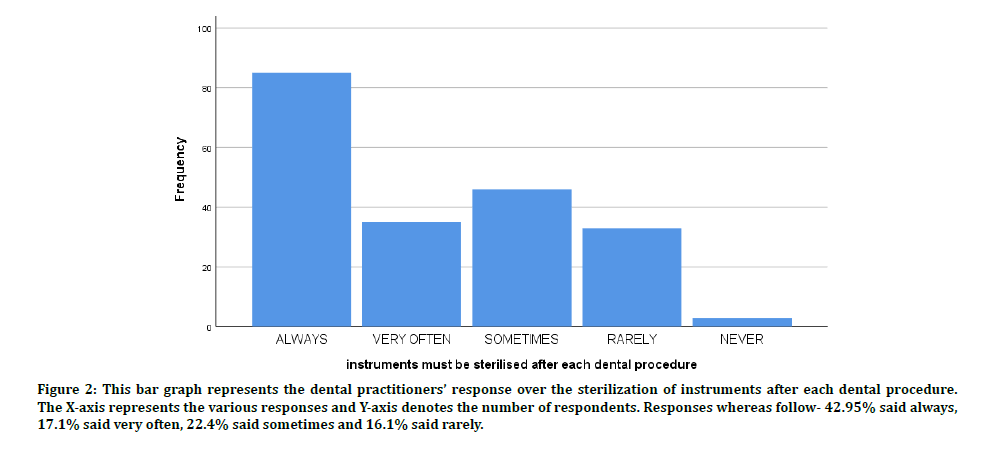
Figure 2: This bar graph represents the dental practitioners’ response over the sterilization of instruments after each dental procedure. The X-axis represents the various responses and Y-axis denotes the number of respondents. Responses whereas follow- 42.95% said always, 17.1% said very often, 22.4% said sometimes and 16.1% said rarely.
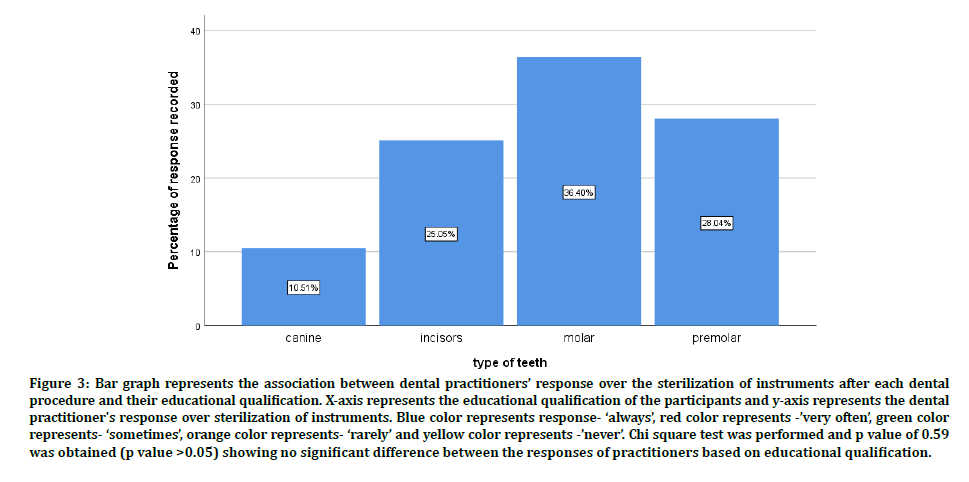
Figure 3: Bar graph represents the association between dental practitioners’ response over the sterilization of instrument s after each dental procedure and their educational qualification. X-axis represents the educational qualification of the participants and y-axis represents the dental practitioner's response over sterilization of instruments. Blue color represents response- ‘always’, red color represents -’very often’, green color represents- ‘sometimes’, orange color represents- ‘rarely’ and yellow color represents -’never’. Chi square test was performed and p value of 0.59 was obtained (p value >0.05) showing no significant difference between the responses of practitioners based on educational qualification.
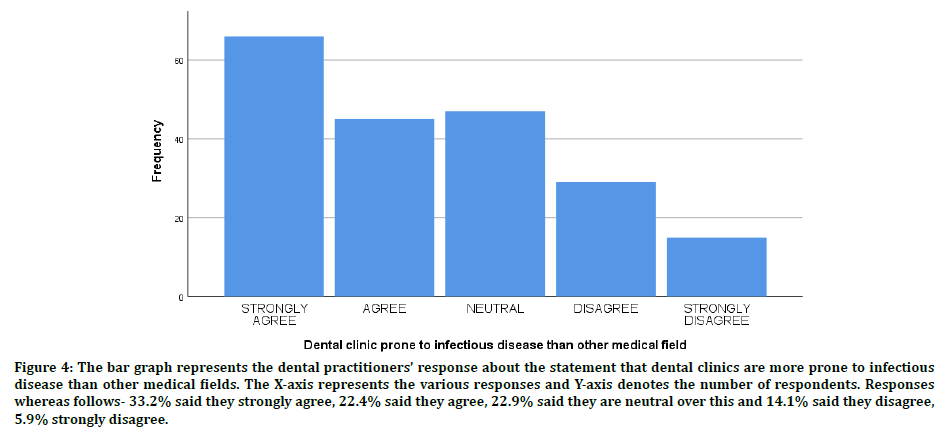
Figure 4: The bar graph represents the dental practitioners’ response about the statement that dental clinics are more prone to infectious disease than other medical fields. The X-axis represents the various responses and Y-axis denotes the number of respondents. Responses whereas follows- 33.2% said they strongly agree, 22.4% said they agree, 22.9% said they are neutral over this and 14.1% said they disagree, 5.9% strongly disagree.
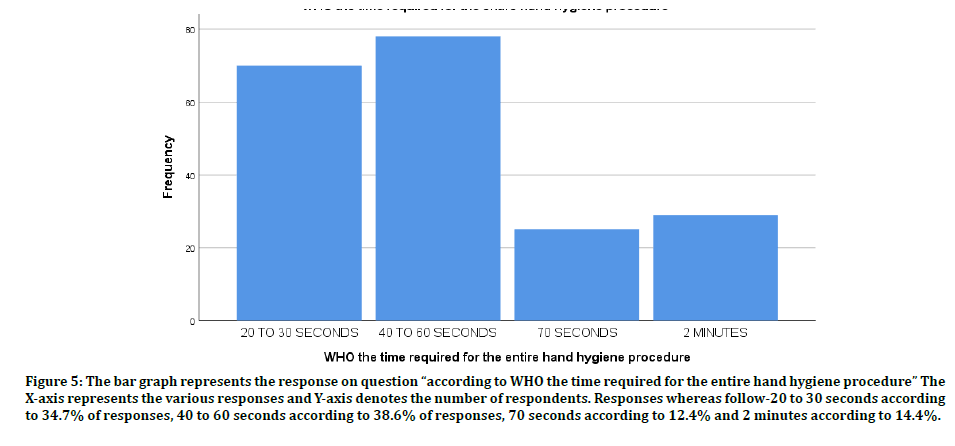
Figure 5: The bar graph represents the response on question “according to WHO the time required for the entire hand hygiene procedure” The X-axis represents the various responses and Y-axis denotes the number of respondents. Responses whereas follow-20 to 30 seconds according to 34.7% of responses, 40 to 60 seconds according to 38.6% of responses, 70 seconds according to 12.4% and 2 minutes according to 14.4%.
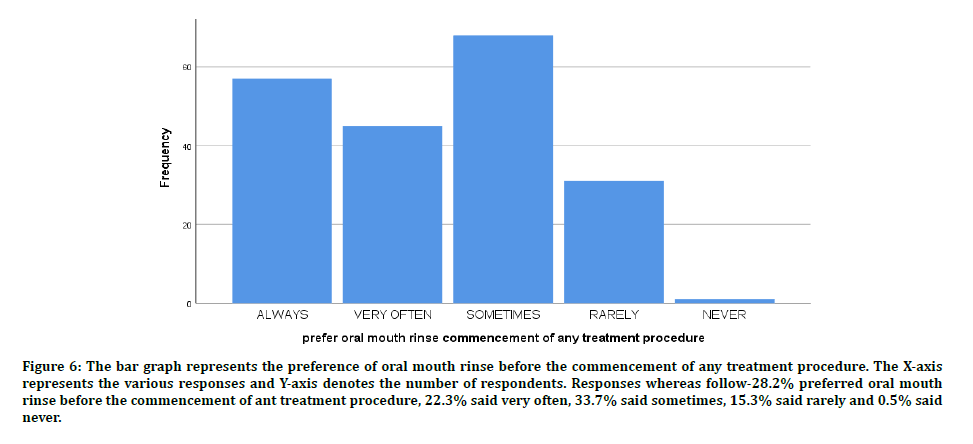
Figure 6: The bar graph represents the preference of oral mouth rinse before the commencement of any treatment procedure. The X-axis represents the various responses and Y-axis denotes the number of respondents. Responses whereas follow-28.2% preferred oral mouth rinse before the commencement of ant treatment procedure, 22.3% said very often, 33.7% said sometimes, 15.3% said rarely and 0.5% said never.
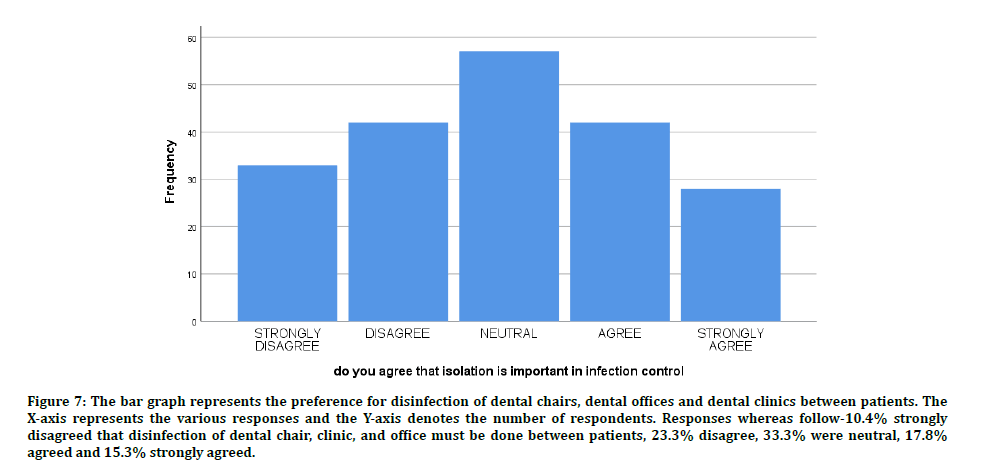
Figure 7: The bar graph represents the preference for disinfection of dental chairs, dental offices and dental clinics between patients. The X-axis represents the various responses and the Y-axis denotes the number of respondents. Responses whereas follow-10.4% strongly disagreed that disinfection of dental chair, clinic, and office must be done between patients, 23.3% disagree, 33.3% were neutral, 17.8% agreed and 15.3% strongly agreed.
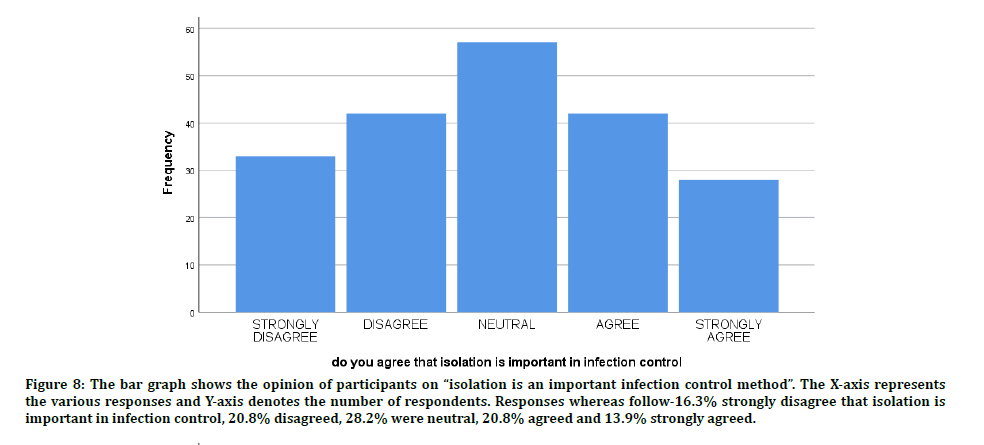
Figure 8: The bar graph shows the opinion of participants on “isolation is an important infection control method”. The X-axis represents the various responses and Y-axis denotes the number of respondents. Responses whereas follow-16.3% strongly disagree that isolation is important in infection control, 20.8% disagreed, 28.2% were neutral, 20.8% agreed and 13.9% strongly agreed.
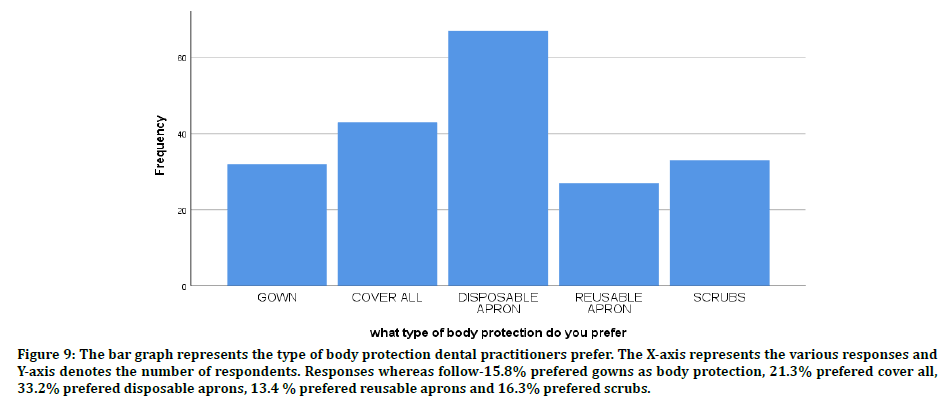
Figure 9: The bar graph represents the type of body protection dental practitioners prefer. The X-axis represents the various responses and Y-axis denotes the number of respondents. Responses whereas follow-15.8% prefered gowns as body protection, 21.3% prefered cover all, 33.2% prefered disposable aprons, 13.4 % prefered reusable aprons and 16.3% prefered scrubs.
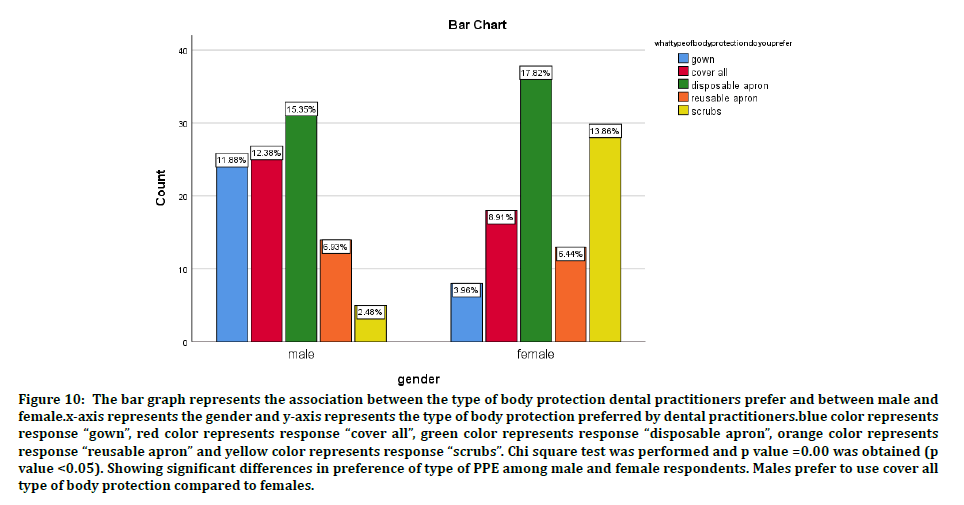
Figure 10: The bar graph represents the association between the type of body protection dental practitioners prefer and between male and female.x-axis represents the gender and y-axis represents the type of body protection preferred by dental practitioners.blue color represents response “gown”, red color represents response “cover all”, green color represents response “disposable apron”, orange color represents response “reusable apron” and yellow color represents response “scrubs”. Chi square test was performed and p value =0.00 was obtained (p value <0.05). Showing significant differences in preference of type of PPE among male and female respondents. Males prefer to use cover all type of body protection compared to females.
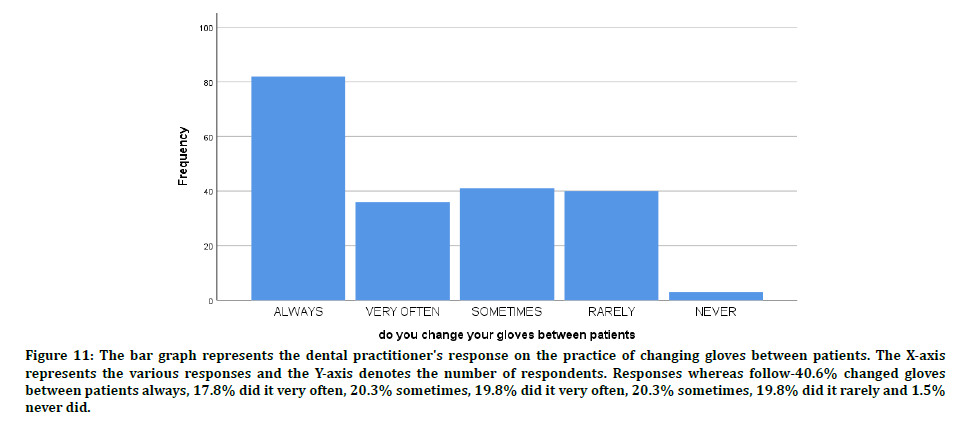
Figure 11: The bar graph represents the dental practitioner's response on the practice of changing gloves between patients. The X-axis represents the various responses and the Y-axis denotes the number of respondents. Responses whereas follow-40.6% changed gloves between patients always, 17.8% did it very often, 20.3% sometimes, 19.8% did it very often, 20.3% sometimes, 19.8% did it rarely and 1.5% never did.
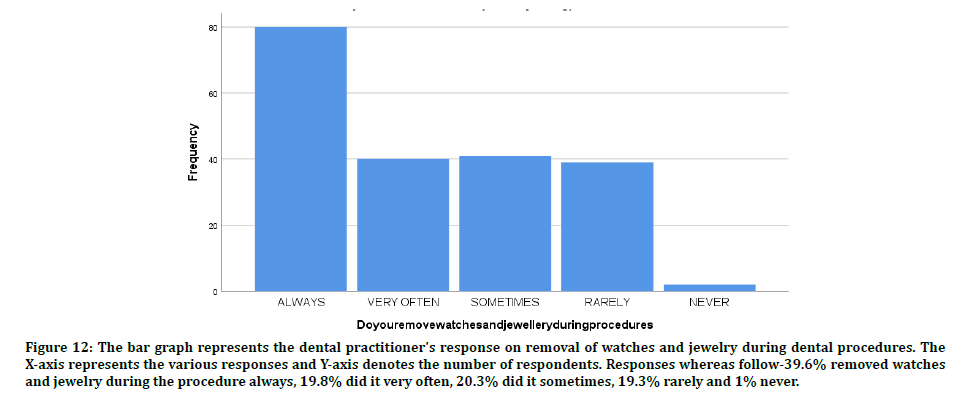
Figure 12: The bar graph represents the dental practitioner's response on removal of watches and jewelry during dental procedures. The X-axis represents the various responses and Y-axis denotes the number of respondents. Responses whereas follow-39.6% removed watches and jewelry during the procedure always, 19.8% did it very often, 20.3% did it sometimes, 19.3% rarely and 1% never.
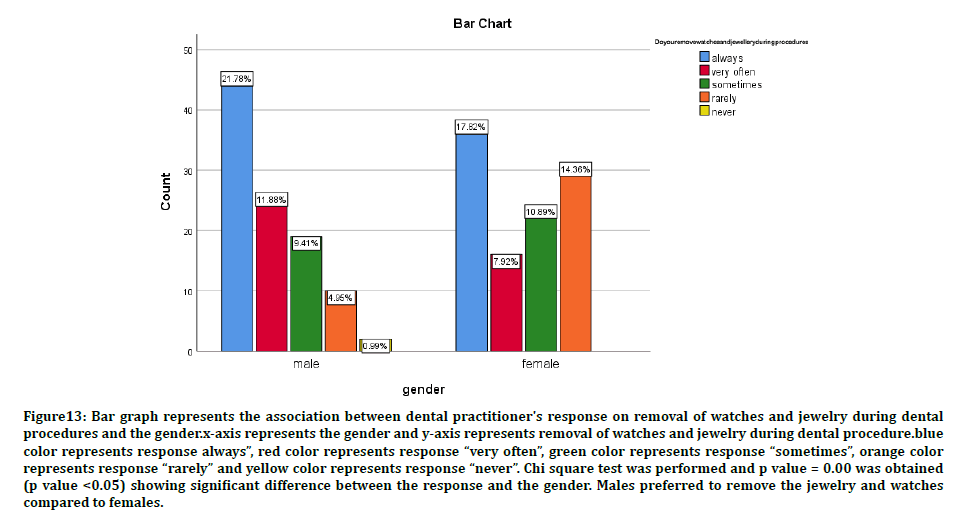
Figure 13: Bar graph represents the association between dental practitioner's response on removal of watches and jewelry during dental procedures and the gender.x-axis represents the gender and y-axis represents removal of watches and jewelry during dental procedure.blue color represents response always”, red color represents response “very often”, green color represents response “sometimes”, orange color represents response “rarely” and yellow color represents response “never”. Chi square test was performed and p value = 0.00 was obtained (p value <0.05) showing significant difference between the response and the gender. Males preferred to remove the jewelry and watches compared to females.
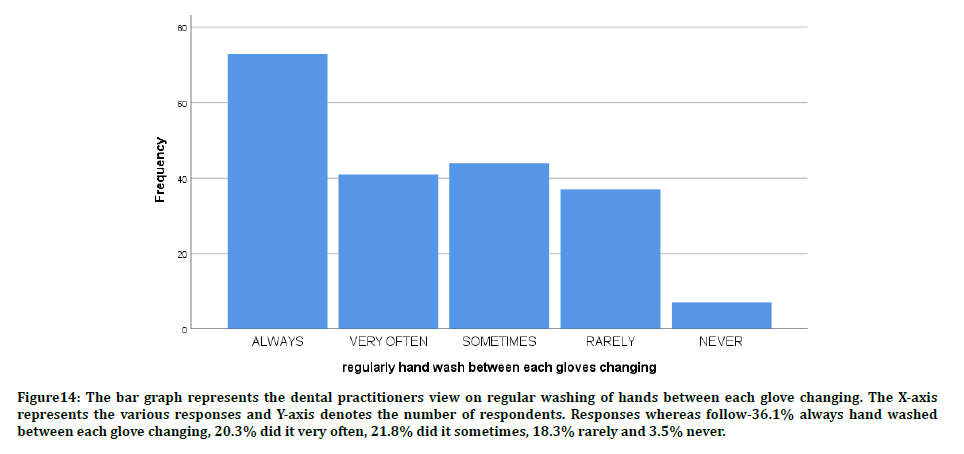
Figure 14: The bar graph represents the dental practitioners view on regular washing of hands between each glove changing. The X-axis represents the various responses and Y-axis denotes the number of respondents. Responses whereas follow-36.1% always hand washed between each glove changing, 20.3% did it very often, 21.8% did it sometimes, 18.3% rarely and 3.5% never.
Discussion
The use of ppe was much more relevant in the current scenario and its importance was emphasized worldwide due to the covid-19 pandemic. The present study throws light into the awareness of dental practitioners on the use of ppe. In the study conducted, 42. 9% sterilize the instruments always and 17.1% did it very often, 22. 4% did it sometimes and 16.1% did it rarely this was in acceptance with the study conducted by yemen in sana’s university the possible reason was good awareness about hygiene. The purpose of sterilization and disinfection procedures was to prevent transmission of microbes to patients.
The responses from participants concluded that 17.7% strongly agreed that isolation was important in infection controlling, 21% agreed, 27.8% was neutral, 20. 5% disagreed, and 13. 7% strongly disagreed. These results were in contradiction with the previous studies. In the previous study 74.6% of people agreed that isolation was important in infection control. Possible reasons would be less awareness and knowledge. The infection-controlled technique of patient isolation may be a system changed that predisposes patients to errors and adverse events. Such strategies, sometimes referred to as transmission-based precautions, were intended to prevent the spread of pathogens by airborne, droplet, or contact transmission. The recommended precautions depend on the infectious agent but typically involve placing the patient in a private room, requiring visitors to wear protective apparel (e.g. gloves, gowns, and masks), and restricting the movement of the patient outside the room. Infection controlled authorities view patient isolation as an important tool for the management of few established and emerging infectious diseases also based on the response from the survey 33. 2% strongly agreed that dental clinics were more prone to infections, 22. % agreed, 22.9% was neutral, 14.1% disagreed, and 5. 9% strongly disagreed this was in acceptance with the previous studies. In the previous study 95. 8% knew that dental clinics were more prone to the transmission of infectious disease than other medical clinics. The possible reason would be good awareness. The opportunity for transmission from patient to dentist was greatest, as dentists were frequently in contact with patients’ blood and bloodcontaminated saliva during dental procedures.
In the present study, 39% of the participants always removed their watches and jewelry during any dental procedure which was in accordance with a study conducted by Sana’s university. A possible reason was good knowledge of personal protective equipment. Also, it’s a matter of concern that 20% of the practitioners don’t remove their jewelry and 20% removed it at times only while doing surgical procedures or wearing gloves. Jewelry could be a source of infection and this practice of not removing the jewelry should be addressed and proper awareness should be created about the protocol to be followed.
The findings of our study proved that the majority of the dental practitioners were aware of the protocols to be followed in the usage of ppe, yet it’s a matter of concern that still quite a relevant percentage of practitioners were not completely adhering to or not practicing the required infection controlled preventive measures. This will risk the safety of the dentists, the auxiliary staff as well as the patients. Hence, the authors felt that it’s important that continuous monitoring by health care authorities was required in this matter and awareness programs to implement protocols should be done on a regular basis. Limitations of this survey were that a convenience sample was chosen, limited sample size, online platform for conducting the survey than direct interviews. The future scope could be more inventions to make better personal protective equipment and to educate more dental practitioners on personal protective equipment’s.
Conclusion
Within the limits of study knowledge and awareness about personal protective equipment was evaluated. It was found that the majority of dental practitioners had adequate knowledge regarding the use of personal protective equipment and hygiene practices, although the percentage of respondents with inadequate knowledge and practice requires attention and adequate measures should be taken to improve their awareness on use of PPE and hygiene practices.
References
Within the limits of study knowledge and awareness about personal protective equipment was evaluated. It was found that the majority of dental practitioners had adequate knowledge regarding the use of personal protective equipment and hygiene practices, although the percentage of respondents with inadequate knowledge and practice requires attention and adequate measures should be taken to improve their awareness on use of PPE and hygiene practices.
References
- Mayer A. European directives and standards relating to personal protective equipments, in performance of protective clothing: West conshohocken. ASTM Int 1992; 4: 990-1000.
- Kaur S. A descriptive study to assess the knowledge of labour workers regarding personal protective equipments in baru sahib, Distt Sirmour, Himachal Pradesh. NHIJ 2017: 7.
- Ahmed H. Trend of wearing personal protective equipment by dentists in Karachi, Pakistan. J Adv Med 2019: 26:1–5.
- Govindaraju L, Jeevanandan G, Subramanian EMG. Comparison of quality of obturation and instrumentation time using hand files and two rotary file systems in primary molars: A single-blinded randomized controlled trial. J Adv Med Med Res 2017; 11: 376–379.
- Miller CH, Palenik CJ. Infection control and management of hazardous materials for the dental team. Mosby 2018; 336.
- Kohli A, Puttaiah R. Dental infection control & occupational safety for oral health professionals. Dental Council of India 2008; 99.
- Lakshmanan L, Mani G, Jeevanandan G, et al. Assessing the quality of obturation and instrumentation time using Kedo-S files, Reciprocating files and Hand K-files. Braz Dent Sci 2020; 23.
- Ramakrishnan M, Shukri MM. Fluoride, fluoridated toothpaste efficacy and its safety in children–Review. Int J Appl Pharm Sci 2018; 10.
- Somasundaram S. Fluoride content of bottled drinking water in Chennai, Tamilnadu. J Clin Diag Res 2015; 9:ZC32.
- Subramanyam D, Gurunathan D, Gaayathri R, et al. Comparative evaluation of salivary malondialdehyde levels as a marker of lipid peroxidation in early childhood caries. Eur J Dent 2018; 12:67–70.
- Gurunathan D, Shanmugaavel AK. Dental neglect among children in Chennai. J Indian Soc Pedod Prev Dent 2016; 34:364–369.
- Jeevanandan G, Govindaraju L. Clinical comparison of Kedo-S paediatric rotary files vs manual instrumentation for root canal preparation in primary molars: A double blinded randomised clinical trial. Eur Arch Paediatr Dent 2018; 19:273–278.
- Govindaraju L, Jeevanandan G, Subramanian E, et al. Clinical evaluation of quality of obturation and instrumentation time using two modified rotary file systems with manual instrumentation in primary teeth. J Clin Diagn Res 2017; 11:55–58.
- Panchal V, Jeevanandan G, Subramanian E, et al. Comparison of instrumentation time and obturation quality between hand K-file, H-files, and rotary Kedo-S in root canal treatment of primary teeth: A randomized controlled trial. J Indian Soc Pedod Prev Dent 2019; 37:75–79.
- Jeevanandan G. Kedo-S Paediatric rotary files for root canal preparation in primary teeth-Case report. J Clin Diagn Res 2017; 11:ZR03–5.
- Govindaraju L, Jeevanandan G, Subramanian EMG, et al. Knowledge and practice of rotary instrumentation in primary teeth among indian dentists: A questionnaire survey. J Int Oral Health 2017; 9:45.
- Christabel SL, Gurunathan D. Prevalence of type of frenal attachment and morphology of frenum in children, Chennai, Tamil Nadu. World J Dent 2015; 6:203–207.
- Packiri S, Gurunathan D, Selvarasu K, et al. Management of paediatric oral ranula: A systematic review. J Clin Diagn Res 2017; 11:ZE06–9.
- Ravikumar D, Jeevanandan G, Subramanian EMG, et al. Evaluation of knowledge among general dentists in treatment of traumatic injuries in primary teeth: A cross-sectional questionnaire study. Eur J Dent 2017; 11:232–237.
- Nair M, Jeevanandan G, Vignesh R. Comparative evaluation of post-operative pain after pulpectomy with k-files, kedo-s files and mtwo files in deciduous molars -A randomized clinical trial 2018; 21:411–417.
- Minaka IADA, Dwi Astuti I, Sawitri AAS, et al. Association of pesticide use and personal protective equipments with health complaints among horticulture farmers in Buleleng, Bali. J Prev Med 2016; 4:94-103.
- Govindaraju L, Gurunathan D. Effectiveness of chewable tooth brush in children-A prospective clinical study. J Clin Diagn Res 2017; 11:31–34.
- Glaros AG, Gadbury-Amyot CC. How personal protective equipment affects perceptions of dentists. J Am Dent Assoc 1993; 124:82–90.
- Dietz ER, Badavinac R. Safety standards and infection control for dental hygienists. Cengage Learning 2002; 314.
- Fulford MR, Stankiewicz NR. Infection control in primary dental care. Springer 2019; 130.
- Azap A, Erdinç FŞ. Medical mask or N95 respirator: When and how to use? Turk J Med Sci 2020; 50:633-637.
- AlAhdal A, Aljehani W, Ali G, Bayoumi A. Evaluation of knowledge of restorative dental staff about personal protective equipments at selected dental clinics, Saudi Arabia. Int JSci Res 2017; 6:1236–1239.
- Powers NA. The impact of a clear versus opaque personal protective face mask on pediatric dental patients. 1997; 140.
- Gudgin Dickson EF. Personal protective equipment for chemical, biological, and radiological hazards: Design, evaluation, and selection. JWS 2012; 348.
Author Info
Sushma Gopalakrishnan, Kavitha S and Geo Mani*
Department of Pedodontics and Preventive Dentistry, Saveetha Dental College, Saveetha Institute of Medical and Technical Sciences, Saveetha University, Chennai, IndiaCitation: Sushma Gopalakrishnan, Kavitha S, Geo Mani, Knowledge, Attitude, and Practice on Use of Personal Protective Equipments among Dental Practitioners of Tamilnadu, J Res Med Dent Sci, 2020, 8 (7): 153-162.
Received: 27-Sep-2020 Accepted: 21-Oct-2020 Published: 28-Oct-2020
